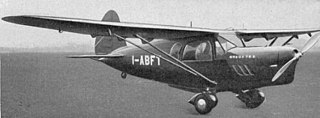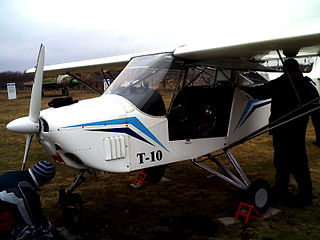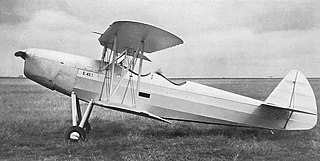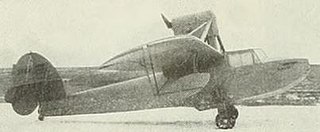Related Research Articles

The Breda Ba.79S was a single-engine four-seat high-wing private aircraft built in Italy in the late 1930s. Only a few were produced.

The TMM Avia T-10 Avia-Tor is a single engine two seat Ukrainian light aircraft, with a high wing and transparent blister cabin doors for extra visibility, designed to be robust enough for a range of applications.
The Iannotta I-66L San Francesco is a 1960s Italian ultralight designed to be homebuilt from plans. It has been powered by several flat-four engines in the 65-100 hp range and built in both single and two-seat tandem configurations. Only small numbers have been completed.

The Arado Ar 77 was a German twin-engined monoplane, designed as an advanced training aircraft from 1934.
The Moskalyev SAM-14 was a late 1930s Soviet, five-passenger transport, one of a series of developments of the successful Moskalyev SAM-5.
The Aydlett A-1 was a one-off, homebuilt aircraft constructed in the US in the 1960s. It was a single seat, single engine monoplane of conventional appearance, with an enclosed cockpit.

The Praga E-40 was a single engine, two seat, biplane basic trainer, built in Czechoslovakia in the mid-1930s.

The Timm T-840 was a twin engine, high wing passenger aircraft designed and flown in the United States in 1938. Equipped with a tricycle undercarriage and low speed aerodynamic devices, it could be configured to carry between six and ten passengers. Only one was built.

The Savoia-Marchetti SM.80 was a two-seat monoplane amphibian tourer, with a single, tractor engine mounted above the wing, designed in Italy in the early 1930s. The SM.80bis was a four-seat variant, powered by two pusher engines.
The Escapade Kid is a single-engine, single-seat, high-wing monoplane, developed and built in the United Kingdom in the 2000s.
The Wendt W-2 Swift was a two-seat, single-engine, braced high-wing monoplane built in the United States just before World War II. Only one was built.

The Legrand-Simon LS.60 is a single-engine, high-wing monoplane seating two side-by-side. It was built in France in the early 1960s in response to a government competition for a club trainer. It won the competition but nevertheless failed to go into production; only the prototype, which still flies, was completed.
The Gidrosamlet Che-24, 26 and 29 are closely related light flying boats designed and built in Russia from 2010.
The Chernov Che-25 is a four-seat, twin engine parasol wing amphibious flying boat built in Russia in the 1990s. The Che-27 is an enlarged, five seat version.

The Caproni Ca.95 was a large, three engine, long range, heavy bomber prototype built in Italy in 1929. It could carry a 1,600 kg (3,500 lb) bomb load and had three defensive gun positions. Only one was built.

The Działowski D.K.D.1 was the first powered aircraft designed by Stanislaw Działowski. It was a low-power high-wing monoplane with a cabin for one passenger. After attending an aviation exhibition in Warsaw in 1927 it was badly damaged when the engine failed as it left and it did not fly again.
The LKL IV and LKL V were a pair of very similar Polish parasol wing two-seaters, built in the early 1930s. They differed primarily in their engines.

The Wallace Touroplane was a late 1920s U.S. three seat, high wing cabin monoplane. About 20 were built.

The Lincoln AP was a U.S., single engine, high wing, general purpose civil cabin aircraft first flown in 1930. Only four were built.

The Argonaut Pirate was a 1930s, U.S., three place, single-engined pusher configuration amphibious aircraft. Only two were built.